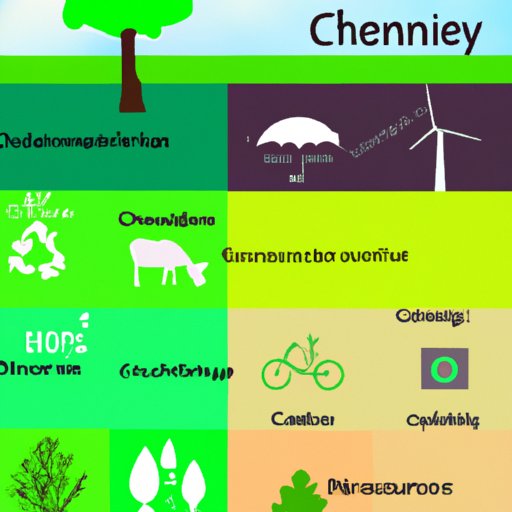Introduction
Climate change is one of the most pressing issues facing the world today. The effects of climate change are already being felt across the globe, from melting glaciers to rising sea levels, droughts, floods, and more severe weather events. It’s essential that we take action now to mitigate the effects of climate change before it’s too late.
Exploring Renewable Energy Sources
One of the most effective ways to combat climate change is to switch to renewable energy sources. Renewable energy sources, such as solar, wind, and hydro power, produce no greenhouse gases and don’t rely on finite resources like fossil fuels.
Solar Power
Solar power is one of the most popular renewable energy sources. Solar panels use the sun’s rays to generate electricity, which can then be used to power homes, businesses, and even entire cities. Solar power is clean, renewable, and relatively inexpensive.
Wind Power
Wind power is another renewable energy source that is becoming increasingly popular. Wind turbines capture the energy of the wind and convert it into electricity. Wind power is clean, renewable, and can be used to power entire communities.
Hydro Power
Hydropower is a renewable energy source that uses the energy of moving water to generate electricity. Hydropower is clean, renewable, and relatively inexpensive. In addition, it can provide a steady supply of electricity.
Developing Carbon Capture Technology
Another way to reduce the effects of climate change is to develop and deploy carbon capture technology. Carbon capture technology captures carbon dioxide (CO2) emissions from power plants and other sources and stores them underground or converts them into useful products.
What is Carbon Capture?
Carbon capture technology captures CO2 emissions from power plants and other industrial sources before they are released into the atmosphere. The captured CO2 is then stored underground or converted into useful products, such as building materials or fuel.
Benefits of Carbon Capture
Carbon capture technology has many benefits. By capturing and storing CO2 emissions, it helps reduce the amount of CO2 entering the atmosphere and contributes to reducing the effects of climate change. In addition, it can also create jobs and economic opportunities in the form of new industries and technologies.
Improving Efficiency
Another way to reduce the effects of climate change is to improve energy efficiency. By using energy more efficiently, we can reduce our emissions and save money in the process.
Energy Efficient Technologies
There are many different types of energy efficient technologies that can help reduce emissions. These include LED lighting, efficient appliances, and energy-saving building materials. By using these technologies, we can reduce our emissions and save money at the same time.
Reducing Emissions Through Efficiency
In addition to using energy efficient technologies, we can also reduce our emissions by using energy more efficiently. This includes using public transportation instead of driving, turning off lights and appliances when not in use, and using renewable energy sources whenever possible.
Planting Trees
Trees are an important part of the fight against climate change. Trees absorb carbon dioxide from the atmosphere and release oxygen back into the air, helping to reduce the amount of CO2 in the atmosphere.
Absorbing Carbon Dioxide
Trees absorb CO2 from the atmosphere through their leaves and roots. This helps to reduce the amount of CO2 in the atmosphere, which helps to mitigate the effects of climate change.
Increasing Oxygen Levels
In addition to absorbing CO2, trees also release oxygen into the air. This helps to increase the amount of oxygen in the atmosphere, which is essential for life on Earth.
Investing in Sustainable Agriculture
Sustainable agriculture is another important part of the fight against climate change. Sustainable agricultural practices can help reduce emissions and increase food production without damaging the environment.
Crop Rotation
Crop rotation is a sustainable agricultural practice that involves growing different crops in the same area over time. This helps to keep soil healthy and reduces the need for chemical fertilizers, which can emit harmful greenhouse gases.
Cover Cropping
Cover cropping is another sustainable agricultural practice that involves planting cover crops between rows of crops. Cover crops help to prevent erosion, retain moisture, and reduce the need for chemical fertilizers.
Reducing Fertilizer Use
Fertilizers are another source of emissions. By reducing the amount of fertilizer used, we can reduce emissions and improve soil health at the same time.
Conclusion
Technology can play a major role in solving climate change. From renewable energy sources to carbon capture technology, energy efficiency, tree planting, and sustainable agriculture, there are many ways that technology can help reduce the effects of climate change. However, it’s essential that we act now to make sure that these solutions are implemented before it’s too late.
(Note: Is this article not meeting your expectations? Do you have knowledge or insights to share? Unlock new opportunities and expand your reach by joining our authors team. Click Registration to join us and share your expertise with our readers.)
